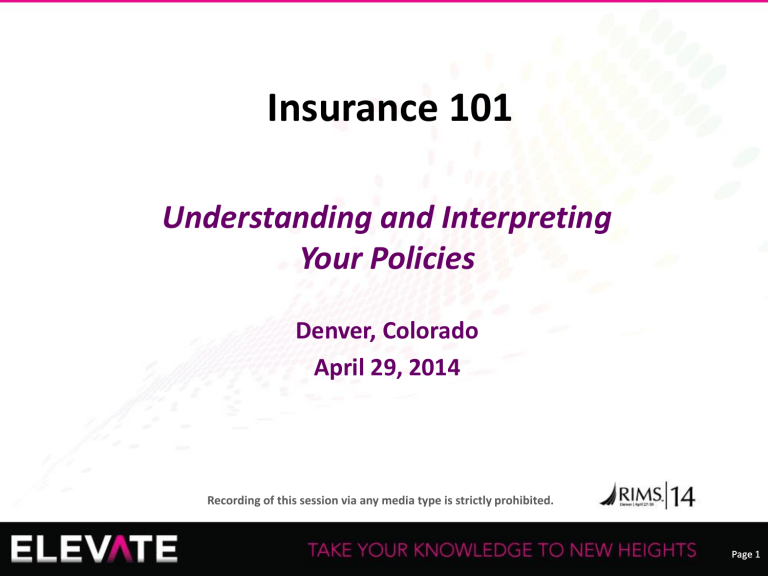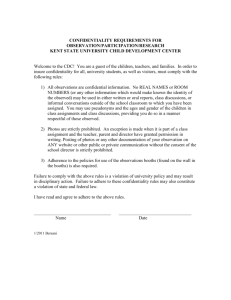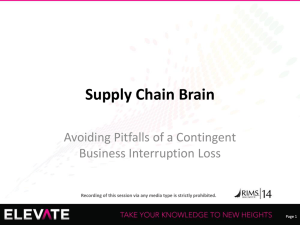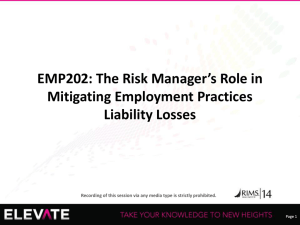First Party Property Insurance

Insurance 101
Understanding and Interpreting
Your Policies
Denver, Colorado
April 29, 2014
Recording of this session via any media type is strictly prohibited.
Insurance 101
Lawrence A. Hobel
Partner, Covington & Burling LLP
Lawrence Hobel advises domestic and international clients on policyholder coverage and complex environmental matters and litigation. Mr. Hobel has served as lead counsel in numerous major coverage actions, and has secured in excess of $1.5 billion dollars in insurance recoveries for extraordinary losses. He has represented policyholders in litigation and negotiations on a broad range of insurance recovery claims and coverage, including first party property damage and business interruption loss, D&O and E&O disputes, privacy and data breach claims, third party toxic tort, asbestos, product liability, and environmental liability coverage. He is listed in various publications of leading lawyers, including being ranked both nationally and in California by Chambers USA.
Lorin Klein
Risk Management, Senior Risk Engineer, Whirlpool Corporation
Lorin Klein manages the loss control engineering services for Whirlpool as well as manages day to day loss control activities for Whirlpool worldwide, including Business Continuity Planning and addressing critical exposures for the company. Lorin was previously employed by several large commercial property insurance carriers handling large commercial risk accounts as both an engineer and underwriter. He has experienced large property claim losses from both the insurer and insured sides of the business.
Jaco Sadie
Managing Director, Insurance Claim Services, FTI Consulting
J aco Sadie is a forensic accountant, based in San Francisco, and leads the west coast region of the Business Insurance Claims practice for FTI Consulting. Mr. Sadie has significant experience preparing complex property damage and business interruption claims. He has prepared claims for companies in the U.S., Asia, Latin America and Africa.
Recording of this session via any media type is strictly prohibited.
Page 2
What to Expect
Expectations Upon Completion of the Session
• Overview of Key Coverage Issues in First Party and
Third Party Insurance
• Better Understanding of Interplay between Language and Outcomes
• Differences in First and Third Party Coverage
• Winning prizes
Recording of this session via any media type is strictly prohibited.
Page 3
Agenda
• Policy Formation
• First Party Property Insurance: The Basics
• Third Party Insurance: The Basics
• Managing the Loss
• Resolving Insurance Coverage Disputes
• Disclaimer: The presentation is not intended to set forth the views of the participants on particular issues and may not accurately reflect such views and is not intended to represent the views of
FTI, Covington or Whirlpool
Recording of this session via any media type is strictly prohibited.
Page 4
Policy Formation – The Application
• Law generally imposes a duty to communicate in good faith to the insurer material facts within insured’s knowledge
Materiality may be determined by test (e.g., subjective test – materiality determined solely by the probable and reasonable influence of facts upon that insurer’s underwriting decision)
Watch out for provisions in application (or under law) to communicate material changes to answers before policy issued
• Some answers to questions on insurance applications may be deemed material as a matter of law:
Answers to specific questions asked by the insurer (courts split)
Insurers seek to establish materiality by so stating in application or policy:
(e.g., “Any statements in the Application and in any materials provided shall be deemed material . . .”)
Recording of this session via any media type is strictly prohibited.
Page 5
Policy Formation – The Application
• Insured may defend claims of misrepresentation/concealment, such as where:
The inquiry or question was vague or ambiguous
The insurer discovered contrary information through independent investigation before issuing the policy – triggering insurer “duty of further inquiry”
Insurer cannot play “gotcha”
• Insured does not warrant accuracy of statements “on information and belief” (unless information comes from sources under the insured’s control)
Recording of this session via any media type is strictly prohibited.
Page 6
Rescission of Policy by Insurer
Rescission: right, typically exercisable by the insurer, to extinguish the insured’s contract rights based on:
• False representations or concealment of material facts in application
Burden of proof is on the insurer to establish a (i) false representation or concealment and (ii) materiality
• May not have to be related to risk for which loss occurred
• Should require Insurer to pay back premiums
Recording of this session via any media type is strictly prohibited.
Page 7
Reformation of Policy
• Reformation: equitable remedy that allows courts to rewrite policies that fail to conform to the parties’ prior agreement
• Requirements:
Antecedent agreement as to which there was no mistake
Insurance policy with materially different terms, resulting from:
• Fraud
• Inequitable conduct
• Mutual mistake o Unilateral mistake not sufficient
Recording of this session via any media type is strictly prohibited.
Page 8
Policy Interpretation
• Plain language is applied where it is unambiguous.
• If ambiguous, the court considers the “reasonable expectations of the insured” or sometimes, reasonable expectation of the parties.
• Courts generally allow the use of extrinsic evidence to ascertain the insured’s reasonable expectations. Typically not uncommunicated intent.
• If the meaning of the provision does not appear from the plain language and the insured’s reasonable expectations cannot be ascertained, the policy is
construed against the insurer (Contra proferentem).
• Insurers seek to impose more insurer favorable interpretative rules based upon (i) sophisticated insured; (ii) manuscript negotiations; and (iii) custom and practice and technical terms.
• Exclusions are generally construed narrowly.
• A matter of law for the Court, not an issue for the jury.
Recording of this session via any media type is strictly prohibited.
Page 9
Key Principles of Insurance
1.
Indemnity
The insurance company indemnifies the insured against certain risks for a consideration known as premium.
2.
Insurable Interest
The loss of which will directly affect the insured.
3.
Good Faith
The concept that parties to a contract have an obligation of good faith and fair dealing.
4.
Mitigation
The insured will not behave irresponsibly and will take appropriate steps and actions so that the loss is minimized.
5.
Subrogation
The insurance company acquires legal rights to act on behalf of the insured as against third parties, i.e. the insurance company steps into the shoes of the insured.
6.
Proximate Cause
The cause of loss to ascertain whether the loss is covered under the policy.
Recording of this session via any media type is strictly prohibited.
Page 10
Two Types of Insurance
First
Party
Third
Party
Recording of this session via any media type is strictly prohibited.
Page 11
First Party Loss or
Damage To Owned Property
• “All Risk” Property Damage
• Builder’ s Risk or
Construction All Risk
• Boilers & Machinery
• Hull or Rig Physical Damage
• Vehicles/Mobile Equipment
• Aircraft
• Cargo
• Operator’s Extra
Expense (Well Control)
• Flood
• Quake
• Windstorm
• Terrorism
• Cyber
• Political Risk
• Fidelity and Crime/Theft
Recording of this session via any media type is strictly prohibited.
Page 12
First Party Loss of Revenue or Profit
• Business Interruption (from damage to owned property)
• Loss of Production Income (manufacturing)
• Delay in Start Up (for construction project)
• Loss of Hire (for rigs or vessels)
Recording of this session via any media type is strictly prohibited.
Page 13
Third Party Liability: Injury to Employees
• Worker’s Compensation
• Employer’s Liability
• U.S. Longshoremen & Harbor Workers
• Maritime Liability/Jones Act
• Non-Subscribers’ Liability
• State Funds, where applicable
Recording of this session via any media type is strictly prohibited.
Page 14
Third Party Liability to Others
• General Liability for Personal Injury or Property Damage
• Automobile Liability
• Directors & Officers
• Employment Practices
• Fiduciary Liability (pension plans)
• Environmental/Pollution
• Umbrella/Excess Liability
• Aviation
• Protection & Indemnity/Vessel Owner’s Liability
• Charter’s Liability
Recording of this session via any media type is strictly prohibited.
Page 15
First
Party
Funding and Premium Mechanisms
“Old-Fashioned Way” (Fixed Amount,
Subject to an Audit)
Retrospective Premium Plans (Frequently not part of policy)
Fronting Policies
Captive Insurers and Reinsurers
Deductibles or Self-Insured Retentions
(SIRs) per Occurrence or Loss/Aggregate
Recording of this session via any media type is strictly prohibited.
Third
Party
Page 16
17
Controversy —How to Apply SIRs
•
•
Issue: Once a first-layer excess policy’s aggregate limit has been exhausted, are the second- and higher-layer excess policies subject to a self-insured retention per occurrence for subsequent claims?
Deere & Co. v. Allstate Ins. Co., San Francisco Super. Ct., No.
CGC-03-420927 (Oct. 25, 2013) (Phase III) (yes; maintenance of underlying insurance provision in second-and-higher layers incorporate all but “the premium, the amount and limits of liability” from the first layer, and SIRs are not any of these)
Kaiser Alum. & Chem. Corp. v. Certain Underwriters at Lloyd’s
London, San Francisco Super. Cot., No. 312415 ( Oct. 11 & 31,
2001) (no, according to plain language in second-and-higher layers’ Limit of Liability provision; maintenance provision in those layers does not incorporate SIR contained in the first layer’s Limit of Liability provision)
Recording of this session via any media type is strictly prohibited.
Page 17
18
Retrospective Premium Obligation
• What happens when the policy provides for payment of a retrospective premium and claims are made by entities other than the disappeared entity?
• Transportation Ins. Co. v. Busy Beaver Building Centers, Inc., No.
11-907, 2013 U.S. Dist. LEXIS 121838 (S.D. Ohio Aug. 27, 2013)
Named insured had no duty to pay retros because parent company was only party who paid premiums and insurer did not negotiate right to seek from subsidiaries
Policy issued to Cyclops; BB a subsidiary which paid Cyclops for insurance coverage. BB later became stand-alone corporation and was sued for asbestos-related claims
Insurer provided coverage; BB knew at time it submitted claims that it was no longer owned by Cyclops
Court in SJ ruling: BB never bound by contract between insurer and
Cyclops because BB not a successor
Cyclops responsible for retros
Recording of this session via any media type is strictly prohibited.
Page 18
First Party Property
Insurance: The Basics
Recording of this session via any media type is strictly prohibited.
Page 19
Property Insurance
• Types of property typically insured:
Buildings
Equipment and contents
Personal property
Inventory
• Interest in property of others in the custody of insured (if there is an obligation)
• Types of property typically excluded:
Land
Water
Accounts, bills, deed, notes and evidences of debt
Animals, standing timber, growing crops
Dams and dikes
Recording of this session via any media type is strictly prohibited.
Page 20
Property Insurance – Two Basic
Types of Coverage
• "All risks of direct physical loss unless excluded"
Loss of tangible property
Loss of use of tangible property
Note that forms often are
NOT standard
• "Named Perils" – E.g.,
Fire
Explosion
Collapse
Weather conditions
Computer virus
Riot
Smoke
Debris removal
Recording of this session via any media type is strictly prohibited.
Page 21
Typical Property Insurance Exclusions
• The insurance company will not pay for loss or damage caused directly or indirectly by any of the following:
Earth movement (i.e., earthquake)
Flood
Enforcement of a law or ordinance
Wear and tear, erosion, corrosion, inherent defect, inherent vice
Mold/fungus
Pollution
Mysterious disappearance or unexplained losses
Nuclear reaction or nuclear radiation
Hostile or warlike action
• However, coverage may be added by endorsement or specific risk coverage
Recording of this session via any media type is strictly prohibited.
Page 22
Exceptions to Typical Property
Insurance Exclusions
“If physical damage not excluded by this policy results, then only that resulting damage is insured.”
Or
"In the event that a 'specified cause of loss' results, the
Company will pay for the loss or damage caused by that specified cause of loss.“
Typically referred to as Ensuing Losses
Recording of this session via any media type is strictly prohibited.
Page 23
First Party Causation Issues
• Where All Risk Policy with exclusions or named perils policy, often dispute over whether cause is covered or excluded
• All Risk Policy – insurer bears burden of providing exclusion
• Named Perils – insured bears burden of proving covered
• What was Proximate Cause of Loss o New York: Not remote cause. An excluded cause does not bar coverage if it merely “set the stage for that later event.” Look to causes nearest the loss.
o California: if two causes and one is covered and the other is not, then doctrine of efficient proximate cause. Efficient proximate cause is the predominant cause.
• Policies often contain concurrent causation clauses intended to eliminate or allocate loss where concurrent causes o Flood vs. wind loss
Recording of this session via any media type is strictly prohibited.
Page 24
First Party Property Valuation Issues
• Can be very complex
• Replacement vs. Actual Cash Value
• Like Kind and Quality
• Upgrades/Code Requirements
• Co-insurance/Valuation
Recording of this session via any media type is strictly prohibited.
Page 25
Property Insurance:
Time Element Coverage
Business Interruption Coverage (Time Element Coverage)
• Covers lost profits until some defined time after the loss occurs
• Complicated by interdependencies
• Be aware: The cost accounting or GAAP loss ≠ BI loss
• Important to anticipate potential business interruption losses and insure accordingly
Recording of this session via any media type is strictly prohibited.
Page 26
Typical BI Insuring Agreement
The insurance company will pay for Actual Loss Sustained by the
Insured resulting directly from the necessary interruption of the
Insured's business caused by a peril covered hereunder.
Loss of Gross Earnings:
Loss of Gross Earnings less all charges and expenses that do not necessarily continue during the interruption
Loss of Gross Profit:
The sum of the reduction in sales after a rate of gross profit was applied and the increase in cost of doing business – i.e., the additional expenditure necessarily and reasonably incurred for the sole purpose of avoiding lost sales
Recording of this session via any media type is strictly prohibited.
Page 27
Period of Interruption
Typically:
• Starts at the time of the physical damage
• Ending when, with due diligence and dispatch, the property could be repaired or replaced and made ready for operations
• Under the same or equivalent physical and operating conditions that existed prior to the damage
Recording of this session via any media type is strictly prohibited.
Page 28
Period of Interruption
• Also called “period of restoration”, “loss period” or “period of indemnity”
• Theoretical vs. Actual
• Strikes, delay caused by insured not part of loss period (such as idle period or planned maintenance)
• Delay caused by insurer is part of loss period
Recording of this session via any media type is strictly prohibited.
Page 29
Typical Exclusions From BI Coverage
• Increase in loss due to suspension or cancellation of contracts
• Indirect or remote losses
• Service interruption
• Law or ordinance
• Loss of market
• Planned or rescheduled shutdown
• Loss caused by damage to or destruction of finished stock
Recording of this session via any media type is strictly prohibited.
Page 30
Enhancements to BI Coverage
• Some insureds may purchase coverage for losses resulting when events other than PD to insured's own property occur, e.g.,
Contingent BI coverage
Service interruption
Orders of civil authority
Denied (or impaired) access (ingress/egress)
Interdependencies
Extended period of indemnity coverage
Attraction properties
Recording of this session via any media type is strictly prohibited.
Page 31
First Party – Business Coverage
Business Interruption Quantification Issues
• Period of Indemnity and Extended Period of Indemnity
• Likely Experience if the Incident Did Not Occur
• Ordinary Payroll Coverage
• Idle Periods
• Make-up
• Depreciation
• Extra Expense (costs above normal to continue operations)
• Expediting Expense (costs to reduce loss)
Recording of this session via any media type is strictly prohibited.
Page 32
Third Party
Insurance: The Basics
Recording of this session via any media type is strictly prohibited.
Page 33
General Liability Structures
Primary
• Lower limits of Liability
• Limits can be per occurrence or annual
• Typically provides defense obligation and may not exhaust policy limits
Excess
• May or may not “follow form”
• May contain additional exclusions
• Typically defense costs within policy limits (“Ultimate Net Loss”)
Umbrella
• Higher limits of Liability
• Often broader coverage than primary
• Policy language less standard
Recording of this session via any media type is strictly prohibited.
Page 34
Liability Coverage
Duty to Indemnify
“We will pay those sums that the insured becomes legally obligated to pay as damages because of ‘bodily injury’ or
‘property damage’ [or ‘personal injury’ or ‘advertising injury’] to which this insurance applies.
Covers
• Judgments and Settlements
• Consent to Settlement
• Settlement with Insurer for less than Policy Limits and Exhaustion
Recording of this session via any media type is strictly prohibited.
Page 35
General Liability Coverage
Duty to Defend and Duty to Pay Defense Costs
“We will have the right and duty to defend any ‘suit’ seeking
[damages because of ‘bodily injury’ or ‘property damage’ [or
‘personal injury’ or ‘advertising injury’] to which this insurance applies], even if the allegations of the suit are groundless, false or fraudulent.”
• The insurer is excused from its duty to defend only if the complaint against the insured “can by no conceivable theory raise a single issue
which could bring it within the policy coverage”.
• If the insurer reserves its rights, it may have rights to seek reimbursement (after conclusion of the action) of defense expenses allocable solely to non-covered claims.
• Excess Policies and Payment on DWOPs
Recording of this session via any media type is strictly prohibited.
Page 36
Liability Coverage Trigger
Claims Made Coverage
• Claims Made Coverage focuses on Whether Claim is first made during the Policy period
• Claims Made and Reported also requires reporting during policy period
• Policies typically require notice of circumstances
• Can usually purchase “extended reporting period”
• May have a “retro” date
Recording of this session via any media type is strictly prohibited.
Page 37
Liability Coverage Trigger
Occurrence Issues
• Trigger is Occurrence during the Policy Period
“an accident, including continuous or repeated exposure to substantially the same general harmful conditions”
• Trigger and “long tail” injury
Exposure Theory – when exposed to product
Manifestation Theory – Bodily injury doesn’t occur (and insurance not triggered) until reasonably capable of medical diagnosis
Injury in Fact – Coverage is triggered when the actual injury is shown, retroactively, to have occurred, which can involve multiple policy years
Continuous Trigger – Injury is deemed a continuous process and all policies
(from exposure to manifestation) are triggered
• Number of Occurrences
cause vs. effect
Recording of this session via any media type is strictly prohibited.
Page 38
Liability Coverage – Allocation
• All Sums
Each triggered policy has an independent obligation to pay the full liability
• Pro-Rata
Loss is spread over triggered period
Typically, loss is spread even where no coverage (insolvent insurers, exclusions, SIRs)
• Horizontal vs. Vertical Exhaustion
• Policy Limitations
• Prior/Other Insurance/Other Company Insurance
Recording of this session via any media type is strictly prohibited.
Page 39
Key Exclusions in GL Coverage
Exclusions
• Not Third-Party Property
• Faulty Workmanship by the insured
• Claims covered under Workers Compensation
• Pollution Exclusions
• Intend/ Expect
Recording of this session via any media type is strictly prohibited.
Page 40
41
Claims Against a Disappeared Entity
The case law continues to develop as to the rights of claimants to pursue dissolved entities to the extent of insurance coverage
• Issues respecting rights where corporation law of jurisdiction has a sunset provision
• Issues respecting whether requires dissolved entity to come back to life in some way or simply allows suit be brought against insurer
• Issue respecting whether liability of successor for dissolved corporation
Recording of this session via any media type is strictly prohibited.
Page 41
42
Successors and Coverage
Most policies contain an anti-assignment clause: no "assignment of interest under this policy" without the insurer's consent endorsed on the policy. Such clauses are generally valid and enforceable.
Two exceptions have been asserted by Policyholders:
• Clause should not apply when liability is by operation of law
Where the transaction amounts to a consolidation or merger of the two entities
Where the purchasing corporation is a mere continuation of the seller
The transfer of assets to the purchase is for the fraudulent purpose of escaping liability for the seller’s debts
• Clause should not apply because once the injury or damage insured against has taken place, a policyholder could freely assign its rights to defense and indemnity for claims arising out of that damage or injury
Recording of this session via any media type is strictly prohibited.
Page 42
43
Successor Issues
Case Law Mixed on Assignability after loss
• The Henkel Rule (California Supreme Court)
No assignable chose in action because the duty had not been reduced to a sum of money due or to become due under policy
Assignment without consent only where (i) the claim had been reduced to a monetary sum; or (ii) the insurer was in breach of the policy and the assignment transferred the right to recover damages
California Supreme Court in Fluor considering whether Insurance Code section 520 warrants a different result
– “[a]n Agreement not to transfer the claim of the insured against the insurer after a loss has happened, is void if made before the loss.”
• Some Courts have followed Henkel
E.g., Indiana Supreme Court, relying on reasoning of Henkel
• Other Courts have ignored or rejected Henkel
E.g., Trial Court in Ohio noting that Henkel was in “conflict with” precedent of
Pennsylvania, New York, Delaware, Ohio and Connecticut, generally on the basis that the loss has occurred before the claim is reduced to judgment or the insurer is in breach
Recording of this session via any media type is strictly prohibited.
Page 43
Directors and Officers and Professional
Liability Coverage
D&O Insurance
• Suits against Directors and Officers
• Securities actions against the Company
Professional Liability Insurance (E&O)
• Suits alleging errors and omissions in professional work
Recording of this session via any media type is strictly prohibited.
Page 44
D&O Coverage
Why is D&O Insurance Necessary?
• Corporations typically have bylaws that obligate them to provide broad indemnity to their directors and officers
• It may be financially impossible for an insolvent corporation to indemnify
• It may be legally impossible for a corporation to indemnify derivative claims
Recording of this session via any media type is strictly prohibited.
Page 45
Basics of D&O Coverage
Side A
• Insure directors and officers when they are not indemnified
Side B
• Insure corporations when they indemnify their directors and officers
Side C
• Insure corporations for certain types of direct liability
Recording of this session via any media type is strictly prohibited.
Page 46
Typical D&O Exclusions
• Wrongful Profit
• Deliberate Criminal or Fraudulent Act
• In fact vs. final adjudication – settlements
• Insured v. Insured (e.g., Claims brought by a disgruntled former director or officer)
• Severability Clause - the conduct of one individual will not be imputed to other individuals or to the corporate entity
• Prior Claims
• Regulatory Exclusions
Recording of this session via any media type is strictly prohibited.
Page 47
E&O Basics
• Coverage for Loss Resulting from a Claim made (and reported?) during policy period
• For a “Wrongful Act”
• In the rendering or failing to render “Professional Services”
• Covers claims of errors or omissions: negligence, misrepresentation, violation of good faith and fair dealing, wrong advice
Recording of this session via any media type is strictly prohibited.
Page 48
Cyber Crime Insurance
• Coverage afforded under “traditional” policies and specialty ‘cyber’ policies
• Specialty ‘cyber’ policies could offer both first party and third party and cover:
Losses resulting from data breach, such as defense and indemnity costs relating to third party action, notification costs, credit monitoring, public relations, forensic investigation and crises management
Regulatory investigations, fines and penalties
Losses resulting from a misappropriation of intellectual property
Losses resulting from transmission of malicious code or denial of third party to insured’s network
Cost to recover data
Business interruption
Extortion from cyber attackers
Recording of this session via any media type is strictly prohibited.
Page 49
Managing The Loss
First
Party
Third
Party
Notice of Loss Notice of circumstances
Policy provisions on Proof of Loss and timing
Notice of claim
“Tender” of claim
Partial payment and advance payment Duty to Communicate
Limitations period Managing the Relationship
Examination Under Oath Consent to Settle
Obligations of Insurer and Insured Document Retention
Document Retention
Recording of this session via any media type is strictly prohibited.
Page 50
Reservation of Rights
• Insurer does not waive its rights to contest coverage even though the insurer agrees to provide some performance under the policy
• A policy defense (e.g., failure to give notice or cooperate)
• A coverage defense
• Third-Party Liability -- Once an insurer reserves its rights based on a coverage defense, the insured generally is entitled to
independent counsel of its own selection (“Cumis” counsel)
Recording of this session via any media type is strictly prohibited.
Page 51
Policy Provisions On Resolving
Insurance Coverage Disputes
First
Party
Third
Party
• Selection of adjuster
• Arbitration and Litigation Provisions
Choice of law (Bermuda, NY, English)
Choice of forum (Canada, London,
Singapore, Bermuda, NY)
Selection of ADR organization and rules
Managing conflicts among clauses
Recording of this session via any media type is strictly prohibited.
Page 52
QUESTIONS
Lawrence A. Hobel
Covington & Burling LLP
San Francisco, CA lhobel@cov.com
Lorin Klein
Whirlpool Corporation
Chicago, IL
Lorin_A_Klein_jll@Whirlpool.com
Jaco Sadie
FTI Consulting
San Francisco, CA jaco.sadie@fticonsulting.com
Please complete the session survey on the RIMS14 mobile application.
Recording of this session via any media type is strictly prohibited.
Page 53







